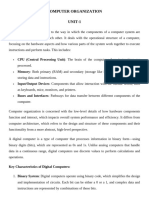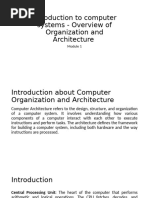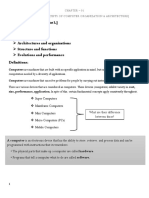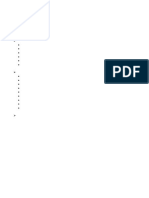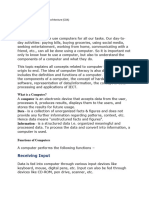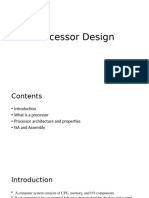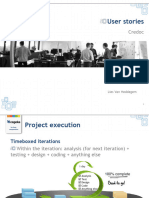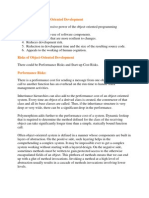0 ratings0% found this document useful (0 votes)
22 views1- Introduction to Computer Architecture
Uploaded by
kapilsharmaiimt335Copyright
© © All Rights Reserved
Available Formats
Download as PDF, TXT or read online on Scribd
0 ratings0% found this document useful (0 votes)
22 views1- Introduction to Computer Architecture
Uploaded by
kapilsharmaiimt335Copyright
© © All Rights Reserved
Available Formats
Download as PDF, TXT or read online on Scribd
You are on page 1/ 9
IntroductIon to computer
ArchItecture
1. Definition of Computer Architecture
At its core, computer architecture defines how a computer is
structured, designed, and organized to achieve its
functionality. It involves both the physical components
(hardware) and the logical system that controls the
processing of data (software). The primary goal of computer
architecture is to optimize the performance and efficiency of
a computer while meeting design constraints like speed,
power consumption, and cost.
2. Key Components of Computer Architecture
The architecture of a computer system consists of several
core components that work together to perform computing
tasks. These include the Central Processing Unit (CPU),
memory systems, and input/output (I/O) devices.
a) Central Processing Unit (CPU)
The CPU, often referred to as the brain of the computer, is
the component responsible for executing instructions and
processing data. It performs the following functions:
• Fetch: The CPU fetches instructions from memory.
• Decode: It decodes the instructions to understand what
operation is required.
• Execute: It performs the required operation (e.g.,
arithmetic or logical computation).
• Store: The result of the operation is stored in memory.
The CPU is made up of several smaller units:
• Control Unit (CU): This component manages and
coordinates the activities of the CPU, instructing it which
task to perform and in what order.
• Arithmetic Logic Unit (ALU): It handles all arithmetic
(e.g., addition, subtraction) and logical (e.g.,
comparisons) operations.
• Registers: These are small, high-speed storage locations
within the CPU used to hold data and instructions
temporarily during processing.
b) Memory
Memory in a computer stores data and instructions needed
for processing. There are two primary types of memory:
• Random Access Memory (RAM): This is the primary
memory where data and instructions that are currently
being processed are stored temporarily. RAM is volatile,
meaning its contents are lost when the computer is
powered off.
• Read-Only Memory (ROM): ROM is non-volatile and
contains essential instructions for booting up the
system. The data in ROM cannot be modified during
regular operations.
Memory is organized in a hierarchical manner to balance
speed, capacity, and cost:
• Cache Memory: Located between the CPU and main
memory (RAM), cache memory is smaller but faster than
RAM. It stores frequently accessed data to improve
processing speed.
• Main Memory (RAM): Larger and slower than cache
memory, this is the workspace for executing applications
and storing temporary data.
• Secondary Storage: Devices like hard drives (HDDs) or
solid-state drives (SSDs) provide long-term storage of
data. Unlike RAM, these are non-volatile and retain data
even when the computer is powered off.
c) Input/Output (I/O) Devices
I/O devices are the interfaces between the user and the
computer. These devices allow for data to be entered into the
computer and for the results of processing to be output.
• Input Devices: Tools like the keyboard, mouse, and
scanner are used to input data into the computer.
• Output Devices: Devices such as monitors, printers, and
speakers allow the user to see or hear the results of the
computer’s processing.
I/O devices communicate with the CPU and memory using
buses—wires or pathways through which data travels inside
the computer.
3. Basic Concepts of Computer Architecture
Several basic concepts form the foundation of computer
architecture. These include the Von Neumann architecture,
instruction sets, and the role of buses in communication
between system components.
a) Von Neumann Architecture
The Von Neumann architecture is a computer design model
proposed by mathematician John von Neumann in 1945. It is
the most widely used architecture in modern computers.
Key principles of the Von Neumann architecture include:
• Single memory for data and instructions: The system
uses the same memory space for both data and
instructions. This means both the program’s code and
the data it manipulates are stored in the same memory.
• Stored-program concept: Programs are stored in
memory alongside data, and the CPU fetches and
executes these instructions sequentially.
• Input, Output, and Processing units: The architecture
includes distinct units for input, output, and processing,
allowing efficient and structured data manipulation.
• Sequential Execution: The CPU fetches one instruction
at a time from memory, decodes it, and executes it. This
sequential execution is one of the defining features of
the Von Neumann architecture.
b) Instruction Set Architecture (ISA)
An instruction set architecture (ISA) is the part of computer
architecture related to programming. It defines the set of
instructions that the CPU can understand and execute. The
ISA serves as the interface between the hardware and the
software. The instructions typically fall into categories such
as:
• Data Transfer Instructions: These move data between
memory and CPU registers.
• Arithmetic/Logic Instructions: These perform
operations like addition, subtraction, comparison, and
bit manipulation.
• Control Instructions: These manage the flow of
execution, including jumps, calls, and conditional
instructions.
4. Buses and Data Communication
In computer architecture, a bus refers to a system of
electrical pathways that allows different parts of the
computer to communicate with each other. There are
different types of buses for various types of communication:
• Data Bus: Transfers actual data between the CPU,
memory, and peripherals.
• Address Bus: Carries information about where data is to
be transferred, specifying the memory location.
• Control Bus: Carries control signals that dictate the
operations being performed (e.g., read or write signals).
The bus system is essential for coordinating how data moves
within the computer and how different components
communicate efficiently.
5. Types of Computer Architecture
Different architectures are designed to meet various
computing needs. These include:
• Single Instruction, Single Data (SISD): This is a
traditional architecture where one instruction operates
on a single piece of data at a time. Most desktop
computers follow this model.
• Single Instruction, Multiple Data (SIMD): Used in vector
processors and some parallel processing systems, this
architecture allows a single instruction to operate on
multiple pieces of data simultaneously.
• Multiple Instruction, Multiple Data (MIMD): Found in
multicore processors, this architecture allows multiple
instructions to be executed on multiple data streams in
parallel, making it ideal for complex computational tasks.
6. Evolution of Computer Architecture
Over time, computer architecture has evolved to address the
increasing demand for higher performance, efficiency, and
power management. Some key milestones include:
• Multicore Processors: Modern CPUs often have multiple
cores that can execute instructions in parallel, increasing
the processing power and allowing for multitasking.
• Parallel Processing: This refers to the simultaneous
execution of multiple processes to improve performance
and speed, particularly for tasks like scientific
simulations or graphics processing.
• Pipelining: A technique where multiple instructions are
overlapped in execution. This is akin to an assembly line,
where different stages of instruction execution (fetch,
decode, execute) occur simultaneously for different
instructions.
Conclusion
Computer architecture is the blueprint for designing and
organizing a computer's hardware and system components. It
governs how the CPU, memory, and input/output devices
work together to process and execute instructions. By
mastering the concepts of computer architecture, BCA
students can better understand how software interacts with
hardware, how to optimize system performance, and how
different architectural choices influence the design and
capabilities of modern computers.
You might also like
- Hourglass Workout Program by Luisagiuliet 276% (21)Hourglass Workout Program by Luisagiuliet 251 pages
- The Hold Me Tight Workbook - Dr. Sue Johnson100% (16)The Hold Me Tight Workbook - Dr. Sue Johnson187 pages
- Read People Like A Book by Patrick King-Edited62% (66)Read People Like A Book by Patrick King-Edited12 pages
- Livingood, Blake - Livingood Daily Your 21-Day Guide To Experience Real Health77% (13)Livingood, Blake - Livingood Daily Your 21-Day Guide To Experience Real Health260 pages
- COSMIC CONSCIOUSNESS OF HUMANITY - PROBLEMS OF NEW COSMOGONY (V.P.Kaznacheev,. Л. V. Trofimov.)94% (212)COSMIC CONSCIOUSNESS OF HUMANITY - PROBLEMS OF NEW COSMOGONY (V.P.Kaznacheev,. Л. V. Trofimov.)212 pages
- Donald Trump & Jeffrey Epstein Rape Lawsuit and Affidavits83% (1016)Donald Trump & Jeffrey Epstein Rape Lawsuit and Affidavits13 pages
- The 36 Questions That Lead To Love - The New York Times94% (34)The 36 Questions That Lead To Love - The New York Times3 pages
- The 36 Questions That Lead To Love - The New York Times95% (21)The 36 Questions That Lead To Love - The New York Times3 pages
- Jeffrey Epstein39s Little Black Book Unredacted PDF75% (12)Jeffrey Epstein39s Little Black Book Unredacted PDF95 pages
- The 4 Hour Workweek, Expanded and Updated by Timothy Ferriss - Excerpt23% (954)The 4 Hour Workweek, Expanded and Updated by Timothy Ferriss - Excerpt38 pages
- Daraz - Online Shopping Case Study Report UmeshNiure RamTamang0% (1)Daraz - Online Shopping Case Study Report UmeshNiure RamTamang23 pages
- Architecture of Computers: Vistula UniversityNo ratings yetArchitecture of Computers: Vistula University34 pages
- Fundamentals of Computer Assignment ReportNo ratings yetFundamentals of Computer Assignment Report27 pages
- Introduction To Computer Organization and Architecture-1No ratings yetIntroduction To Computer Organization and Architecture-115 pages
- Introduction To Computer Organization and Architecture-1No ratings yetIntroduction To Computer Organization and Architecture-115 pages
- Module 1. Introduction.. Overview of Computer Organization and ArchitectureNo ratings yetModule 1. Introduction.. Overview of Computer Organization and Architecture58 pages
- Computer Architecture and Organization: Adigrat University Electrical and Computer Engineering Dep'tNo ratings yetComputer Architecture and Organization: Adigrat University Electrical and Computer Engineering Dep't35 pages
- Fixed Program Computers - Their Function Is Very: Von Neumann ArchitectureNo ratings yetFixed Program Computers - Their Function Is Very: Von Neumann Architecture12 pages
- Computer Organization and Architecture NotesNo ratings yetComputer Organization and Architecture Notes15 pages
- Computer Organization and Architecture (COA) Chapter - 1 Introduction of ComputerNo ratings yetComputer Organization and Architecture (COA) Chapter - 1 Introduction of Computer44 pages
- 1-Introduction Computer Organization & ArchitectureNo ratings yet1-Introduction Computer Organization & Architecture16 pages
- Advanced Computer Architecture: CSE-401 ENo ratings yetAdvanced Computer Architecture: CSE-401 E71 pages
- Fundamentals of Modern Computer Architecture: From Logic Gates to Parallel ProcessingFrom EverandFundamentals of Modern Computer Architecture: From Logic Gates to Parallel ProcessingNo ratings yet
- 2 Marks: Question Bank Unit-Iv Memory SystemNo ratings yet2 Marks: Question Bank Unit-Iv Memory System2 pages
- This Study Resource Was: Running Head: Comparison of Owasp and OsstmmNo ratings yetThis Study Resource Was: Running Head: Comparison of Owasp and Osstmm4 pages
- Information Security Manual For Safe Usage of ITNo ratings yetInformation Security Manual For Safe Usage of IT39 pages
- Selve Amiche, Ombrose Piante - Sim - High VoiceNo ratings yetSelve Amiche, Ombrose Piante - Sim - High Voice1 page
- Social Media Marketing Is A Powerful Way For Businesses of All Sizes To Reach Prospects and CustomersNo ratings yetSocial Media Marketing Is A Powerful Way For Businesses of All Sizes To Reach Prospects and Customers2 pages
- Benefits of The Object-Oriented DevelopmentNo ratings yetBenefits of The Object-Oriented Development13 pages
- Cost Model For Data Management Center (DMC) Main Menu0% (1)Cost Model For Data Management Center (DMC) Main Menu63 pages
- PowerMaxOS+10+Data+Mobility Open-Minimally+Disruptive+Migration+O-MDM Participant+GuideNo ratings yetPowerMaxOS+10+Data+Mobility Open-Minimally+Disruptive+Migration+O-MDM Participant+Guide34 pages
- WhatsApp Chat With MY PRAVEEN-XII 2024 OFFICIALNo ratings yetWhatsApp Chat With MY PRAVEEN-XII 2024 OFFICIAL2 pages
- Livingood, Blake - Livingood Daily Your 21-Day Guide To Experience Real HealthLivingood, Blake - Livingood Daily Your 21-Day Guide To Experience Real Health
- COSMIC CONSCIOUSNESS OF HUMANITY - PROBLEMS OF NEW COSMOGONY (V.P.Kaznacheev,. Л. V. Trofimov.)COSMIC CONSCIOUSNESS OF HUMANITY - PROBLEMS OF NEW COSMOGONY (V.P.Kaznacheev,. Л. V. Trofimov.)
- Donald Trump & Jeffrey Epstein Rape Lawsuit and AffidavitsDonald Trump & Jeffrey Epstein Rape Lawsuit and Affidavits
- The 36 Questions That Lead To Love - The New York TimesThe 36 Questions That Lead To Love - The New York Times
- The 36 Questions That Lead To Love - The New York TimesThe 36 Questions That Lead To Love - The New York Times
- Jeffrey Epstein39s Little Black Book Unredacted PDFJeffrey Epstein39s Little Black Book Unredacted PDF
- The 4 Hour Workweek, Expanded and Updated by Timothy Ferriss - ExcerptThe 4 Hour Workweek, Expanded and Updated by Timothy Ferriss - Excerpt
- Daraz - Online Shopping Case Study Report UmeshNiure RamTamangDaraz - Online Shopping Case Study Report UmeshNiure RamTamang
- Introduction To Computer Organization and Architecture-1Introduction To Computer Organization and Architecture-1
- Introduction To Computer Organization and Architecture-1Introduction To Computer Organization and Architecture-1
- Module 1. Introduction.. Overview of Computer Organization and ArchitectureModule 1. Introduction.. Overview of Computer Organization and Architecture
- Computer Architecture and Organization: Adigrat University Electrical and Computer Engineering Dep'tComputer Architecture and Organization: Adigrat University Electrical and Computer Engineering Dep't
- Fixed Program Computers - Their Function Is Very: Von Neumann ArchitectureFixed Program Computers - Their Function Is Very: Von Neumann Architecture
- Computer Organization and Architecture (COA) Chapter - 1 Introduction of ComputerComputer Organization and Architecture (COA) Chapter - 1 Introduction of Computer
- 1-Introduction Computer Organization & Architecture1-Introduction Computer Organization & Architecture
- Fundamentals of Modern Computer Architecture: From Logic Gates to Parallel ProcessingFrom EverandFundamentals of Modern Computer Architecture: From Logic Gates to Parallel Processing
- This Study Resource Was: Running Head: Comparison of Owasp and OsstmmThis Study Resource Was: Running Head: Comparison of Owasp and Osstmm
- Social Media Marketing Is A Powerful Way For Businesses of All Sizes To Reach Prospects and CustomersSocial Media Marketing Is A Powerful Way For Businesses of All Sizes To Reach Prospects and Customers
- Cost Model For Data Management Center (DMC) Main MenuCost Model For Data Management Center (DMC) Main Menu
- PowerMaxOS+10+Data+Mobility Open-Minimally+Disruptive+Migration+O-MDM Participant+GuidePowerMaxOS+10+Data+Mobility Open-Minimally+Disruptive+Migration+O-MDM Participant+Guide






































